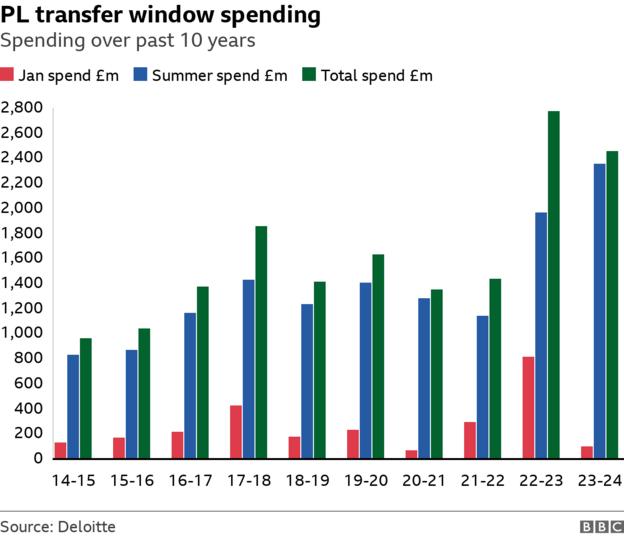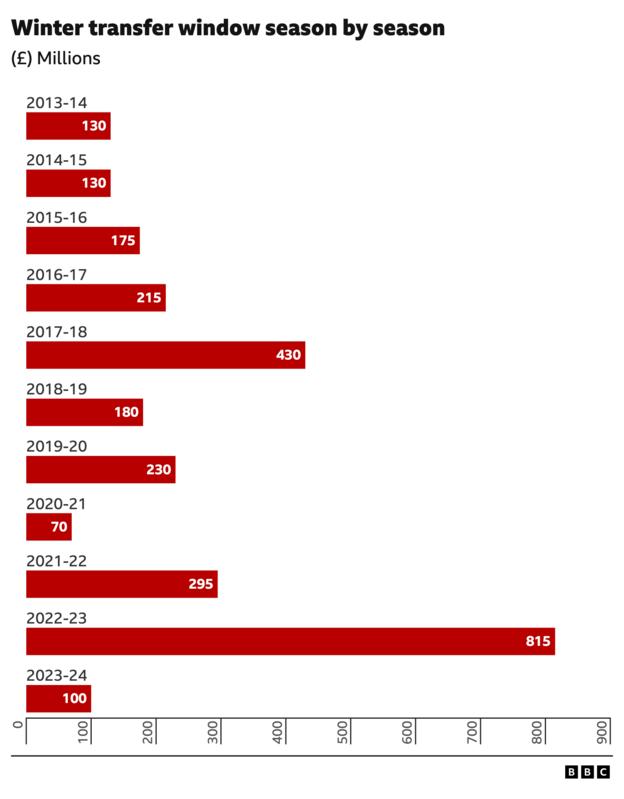Football
January spending down by £715m compared with 2023

Spending by Premier League clubs in January dipped significantly after three successive record-breaking windows – with teams splashing out £715m less than in the 2023 winter window.
The combined outlay of the 20 top-flight clubs was £100m – the lowest January spend in a non-Covid season since £60m in 2011-12 – and vastly lower than last year’s spend of £815m, according to financial services firm Deloitte.
Just £30m in disclosed fees was spent on deadline day, another considerable drop on the £275m spent on the same day 12 months ago.
There were only 17 permanent transfers made by Premier League clubs during the window, with a further 13 loan deals – including seven permanent and six loan deals on deadline day.
Despite the relatively modest January total the 2023-24 season still has the second-highest transfer spend ever, with £2.5bn shelled out across both transfer windows – driven by clubs’ record-breaking expenditure in the summer.
Other notable numbers include:
- English Football League (EFL) spending during the window fell to £15m compared to £25m in January 2023
- Spending across the rest of Europe’s ‘big five’ leagues – Italy’s Serie A, Spain’s La Liga, France’s Ligue 1 and Germany’s Bundesliga – rose to £388m from £218m in the January 2023 window
- Ligue 1 clubs had the highest gross transfer spend among Europe’s ‘big five’ with expenditure of £162m, followed by the Premier League (£100m), Serie A (£85m), Bundesliga (£70m) and La Liga (£70m)
- It is the first January window since 2019 that the Premier League was not the biggest spending league globally – and first window since summer 2011 that it was not Europe’s biggest spending league
- Spending by Saudi Pro League clubs was significantly lower in this January transfer window (£21.3m) compared to the £853m spent in the summer 2023 window.
Tim Bridge, lead partner in Deloitte’s Sports Business Group, said: “After record-breaking spending in the last three transfer windows, Premier League clubs’ spending this January has been subdued.
“The more prudent approach is likely driven by the high level of spend invested during the summer window but may also have been influenced by a heightened awareness of the Premier League’s financial regulations and the potential repercussions of non-compliance.
“Securing the highest quality player talent remains pivotal for Premier League clubs, but we’ve seen in this window that retention has been of higher priority than attraction.”

Financial rules have chilling effect
The charges hanging over Everton and Nottingham Forest for allegedly breaching the Premier League’s Profit and Sustainability Rules (PSR) are likely to have had a chilling effect on spending.
Under the top-flight’s PSR, clubs are only allowed to make losses of £105m over a rolling three-year period.
The Toffees were deducted 10 points in November for breaching the league’s financial rules in their 2021-22 accounts, with the club having appealed against the decision.
Everton and Forest were then charged last month for alleged breaches in their 2022-23 accounts, with their cases due to be dealt with before the end of the season.
Why else is spending down?
There are other factors that may have helped to suppress spending, including:
- Quiet month in foreign leagues, including Saudi Arabia – so there is less money sloshing around the market
- New Uefa cost controls which came in this season – clubs competing in Europe must limit spending to 90% of club revenue, reducing to 70% by 2025.
- Only two manager changes this season – compared to 11 last year, means fewer new managers are looking to bring in their own players
- Back-to-back record windows – means squads are naturally stronger so do not require significant investment
- Spending typically lower in January – the record spend of 2023 is the exception rather than the rule when compared to spending in previous windows
- Emergence of young players – clubs are utilising their academies more rather than bringing in talent, with players such as Conor Bradley, Lewis Miley and Oscar Bobb establishing themselves in their senior sides.

Will spending continue to fall?
“I think what we are storing up is a spending circus in the summer because there has been so much pressure on these clubs,” Professor Rob Wilson, football finance expert at Sheffield Hallam University, told BBC Sport.
“We have seen the news about Everton and their 10-point deduction, the additional charges for Everton and Nottingham Forest and the pressure the huge amount of Premier League is under from the government with regards to an independent regulator, so everybody is a bit scared about what to do right now.
“Managers and sporting directors will be looking keenly at their PSR calculations to see if they can spend a bit more heavily in the summer.
“You’d imagine that the spending will be much heavier in the summer – I just don’t necessarily think it will reach those multi-billion pound levels we have seen in years gone by.”
Calum Ross, assistant director in Deloitte’s Sports Business Group, said: “The domino effect created by high-value transfers and a desire to improve on-pitch performance ahead of the final part of the season are usually key drivers of transfer spending, but this hasn’t been reflected in January’s subdued transfer window.
“As we move towards this summer’s window, and a new financial year, we expect to see spending return to similar levels we have seen in the last two record-breaking summer transfer windows.”

What deals were done on deadline day?
The biggest permanent deal of deadline day was Crystal Palace’s capture of Blackburn midfielder Adam Wharton for an initial £18m, potentially rising to £22m.
That is in sharp contrast to the biggest deal on deadline day in January 2023, which was Chelsea’s then-British record £107m deal for Argentina midfielder Enzo Fernandez from Benfica.
Aston Villa signed forward Morgan Rogers from Middlesbrough in a deal worth £8m that could rise to £15m. Villa also signed Australia keeper Joe Gauci from Adelaide United and full-back Lino Sousa from Arsenal, with the England Under-19 international immediately joining Championship side Plymouth on loan.
Other notable deadline day deals include:
What were the biggest transfers in January?
The most eye-catching deals were high-profile loans, such as Kalvin Phillips’ move from Manchester City to West Ham, Borussia Dortmund re-signing England winger Jadon Sancho from Manchester United and Eric Dier moving to Bayern Munich from Tottenham.
Tottenham made the biggest permanent signing of a low-key window, bringing in 21-year-old Romania defender Radu Dragusin from Italian side Genoa for £25m. They also signed Germany striker Timo Werner on loan from RB Leipzig until the end of the season.
A lot of the other permanent deals involved young players, including 19-year-old Argentine winger/full-back Valentin Barco joining Brighton from Boca Juniors for £7.9m and Manchester City signing Argentina Under-17 midfielder Claudio Echeverri from River Plate.













